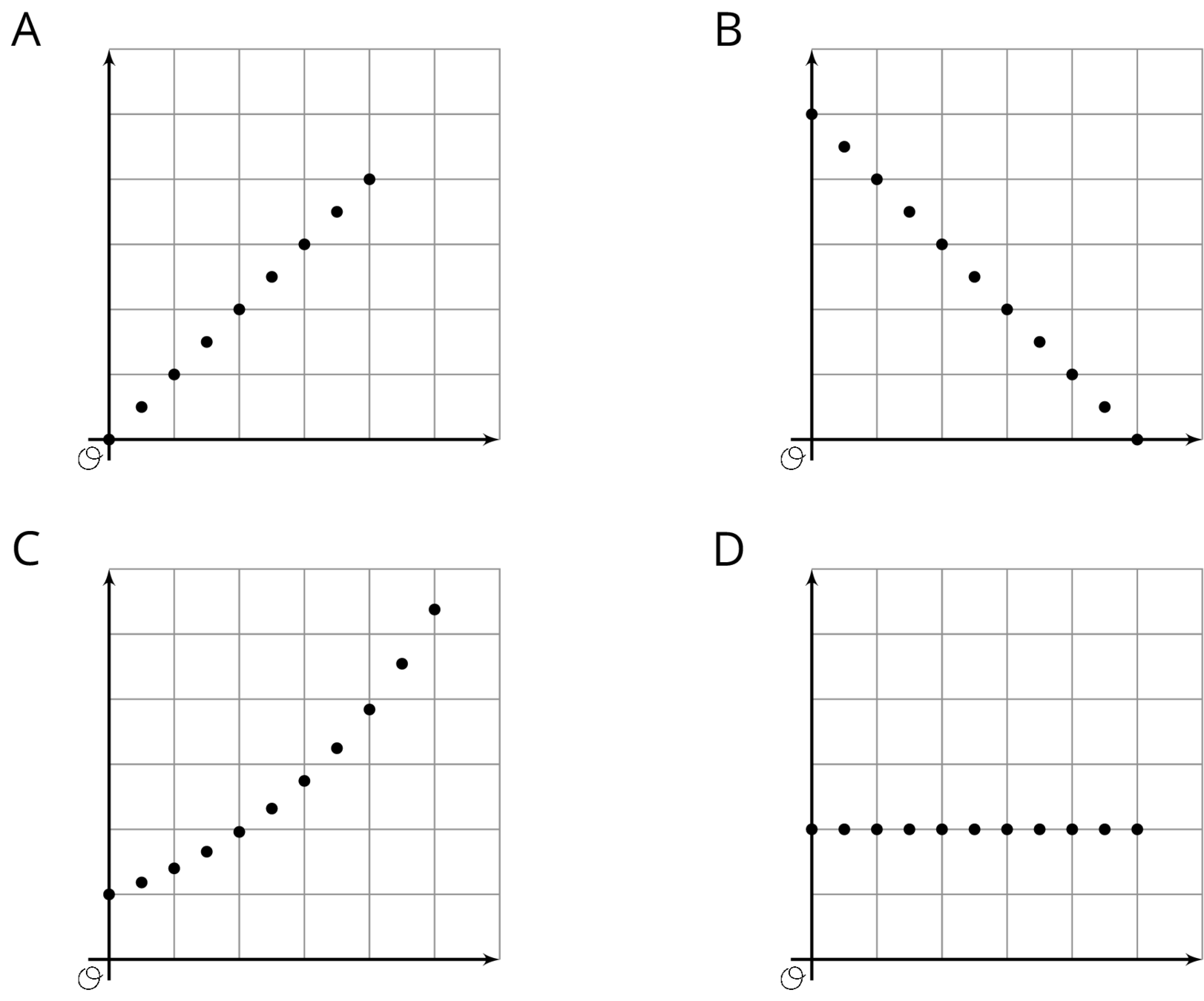Lesson 18
More Relationships
Let’s use graphs and equations to show relationships involving area, volume, and exponents.
18.1: Which One Doesn’t Belong: Graphs
Which one doesn’t belong?

18.2: Making a Banner
Mai is creating a rectangular banner to advertise the school play. The material for the banner is sold by the square foot. Mai has enough money to buy 36 square feet of material. She is trying to decide on the length and width of the banner.
-
If the length is 6 feet, what is the width?
-
If the length is 4 feet, what is the width?
-
If the length is 9 feet, what is the width?
-
To find different combinations of length and width that give an area of 36 square feet, Mai uses the equation \(w=\frac{36}{\ell}\), where \(w\) is the width and \(\ell\) is the length. Compare your strategy and Mai's method for finding the width. How were they alike or different?
-
Use several combinations of length and width to create a graph that shows the relationship between the side lengths of various rectangles with area 36 square feet.
- Explain how the graph describes the relationship between length and width for different rectangles with area 36.
- Suppose Mai used the equation \(\ell=\frac{36}{w}\) to find the length for different values of the width. Would the graph be different if she graphed length on the vertical axis and width on the horizontal axis? Explain how you know.
18.3: Cereal Boxes
A cereal manufacturer needs to design a cereal box that has a volume of 225 cubic inches and a height that is no more than 15 inches.
- The designers know that the volume of a rectangular prism can be calculated by multiplying the area of its base and its height. Complete the table with pairs of values that will make the volume 225 in3.
height (in) 5 9 12 7\(\frac12\) area of base (in2) 75 15 - Describe how you found the missing values for the table.
- Write an equation that shows how the area of the base, \(A\), is affected by changes in the height, \(h\), for different rectangular prisms with volume 225 in3.
-
Plot the ordered pairs from the table on the graph to show the relationship between the area of the base and the height for different boxes box with volume 225 in3.
18.4: Multiplying Mosquitoes
A researcher who is studying mosquito populations collects the following data:
| day in the study \((d)\) |
number of mosquitoes \((n)\) |
|---|---|
| 1 | 2 |
| 2 | 4 |
| 3 | 8 |
| 4 | 16 |
| 5 | 32 |
-
The researcher said that, for these five days, the number of mosquitoes, \(n\), can be found with the equation \(n = 2^d\) where \(d\) is the day in the study. Explain why this equation matches the data.
-
Use the ordered pairs in the table to graph the relationship between number of mosquitoes and day in the study for these five days.
-
Describe the graph. Compare how the data, equation, and graph illustrate the relationship between the day in the study and the number of mosquitoes.
-
If the pattern continues, how many mosquitoes will there be on day 6?
Summary
Equations can represent relationships between geometric quantities. For instance:
- If \(s\) is the side length of a square, then the area \(A\) is related to \(s\) by \(A = s^2\).
- Sometimes the relationships are more specific. For example, the perimeter \(P\) of a rectangle with length \(l\) and width \(w\) is \(P=2l+2w\). If we consider only rectangles with a length of 10, then the relationship between the perimeter and the width is \(P = 20 + 2w\).
Here is another example of an equation with exponent expressing the relationship between quantities:
-
A super ball is dropped from 10 feet. On each successive bounce, it only goes \(\frac{1}{2}\) as high as on the previous bounce.
This means that on the first bounce, the ball will bounce 5 feet high, and then on the second bounce it will only go \(2\frac{1}{2}\) feet high, and so on. We can represent this situation with an equation to find how high the super ball will bounce after any number of bounces.
To find how high the super ball bounces on the \(n^{\rm th}\) bounce, we have to multiply 10 feet (the initial height) by \(\frac{1}{2}\) and multiply by \(\frac{1}{2}\) again for each bounce thereafter; we need to do this \(n\) times. So the height, \(h\), of the ball on the \(n^{\rm th}\) bounce will be \(h =10\left(\frac{1}{2}\right)^n\). In this equation, the dependent variable, \(h\), is affected by changes in the independent variable, \(n\).
Equations and graphs can give us insight into different kinds of relationships between quantities and help us answer questions and solve problems.
Glossary Entries
- coordinate plane
The coordinate plane is a system for telling where points are. For example. point \(R\) is located at \((3, 2)\) on the coordinate plane, because it is three units to the right and two units up.

- dependent variable
The dependent variable is the result of a calculation.
For example, a boat travels at a constant speed of 25 miles per hour. The equation \(d=25t\) describes the relationship between the boat's distance and time. The dependent variable is the distance traveled, because \(d\) is the result of multiplying 25 by \(t\).

- independent variable
The independent variable is used to calculate the value of another variable.
For example, a boat travels at a constant speed of 25 miles per hour. The equation \(d=25t\) describes the relationship between the boat's distance and time. The independent variable is time, because \(t\) is multiplied by 25 to get \(d\).
